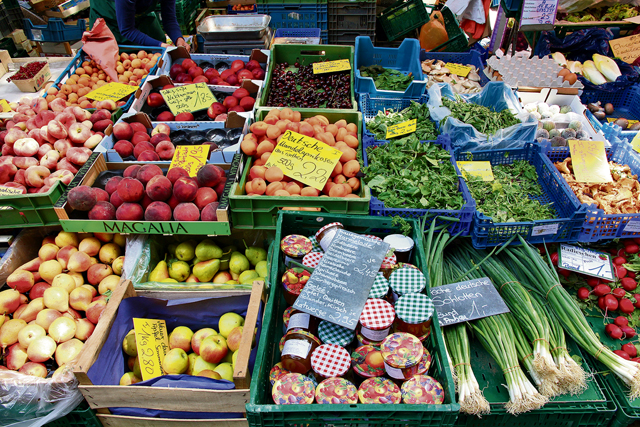
Imagine strolling around a vibrant square where visitors can explore fresh produce, artisanal goods and a lively atmosphere. The fragrance of colorful flowers such as lavender, hydrangeas, roses, bright yellow sunflowers and purple lilac enchant your senses. The appetizing scent of fresh carrots, fennel, ripe red tomatoes, basil and herbs such as parsley, sage rosemary and thyme let your mouth water. Beekeepers selling their regional honey, fresh eggs, dairy products and fresh fish and poultry galore!
Picture yourself carrying home a wicker basket overloaded with colorful vegetables and fruits of the season, you may just be traveling home from one of the many farmers’ or produce markets in the area!
German farmers’ markets have a rich tradition of providing fresh, regional and homemade products. From fruits and vegetables to baked goods and spice, these markets are a feast for the senses.
Almost every larger town in the area offers a “Wochenmarkt” (weekly market) or “Bauernmarkt” (farmers’ market) in weekly, bi-weekly or monthly intervals. Kaiserslautern has a small farmers’ market in Königstrasse held every Thursday, while the larger and better known one at Stiftsplatz on Saturdays has a special story to tell.
A small market tale
For many centuries weekly markets have been held near Stiftskirche in the city center. In the early Middle Ages not every settlement was granted market rights, which fell under strict rules. In the year 985, a market law was documented for the first time as a donation from King Otto III. This meant that “Curtis Luthara” was granted market, customs and ban income rights, which earned the small settlement of about 800 inhabitants great prestige. The document held the signature of Otto III, who at that time was not even five years old. His mother Theophano and the Archbishop of Mainz Willigis had acted on the minor’s behalf.
The fertile land of the early cloister of 1360 (situated near Stiftsplatz today) plays a significant role in the development of the rich selection at the current market stalls. The green garden of the Chorherrenstift (canonical monastery, in conjunction with construction of Stiftskirche in 1250) served as a marketplace with monks and local peasants selling their vegetables and herbs but was surrounded by an ugly stone wall with one entrance.
In the early days, not all decisions made by city leaders were deemed sensible at first site. According to council minutes dated Dec. 19, 1566, there is mention that the textile flag hanging at the entrance would have to be replaced by a metal sign during market hours. The sign would have to display the crest of the imperial coat of arms on one side and the city crest on the other. This would make it evident that the market had the imperial privilege of special protection. Expressions such as market order, market peace and market right were defined in stringent regulations, similar to very precise military regulations today.
As recorded in various council minutes, the Kaiserslauterer Karcherzunft (carter guild) assumed responsibility as “market police” in the 16th century. In September 1570 the guild requested the privilege to hold two livestock markets, which was granted by Emperor Maximilian II and marked a significant milestone in market history.
The original market located behind Stiftskirche changed sites multiple times throughout the centuries, but the growing weekly, livestock and gradually evolving annual fairs called for significant more space. A new square was created by tearing down the old hospital building, public bathing facilities and doing away with the Stiftskirche cloister gardens in 1842, and the farmers’ market finally found its permanent location at Stiftsplatz.
Magnificent buildings surrounded the new market square, for example, a miller named Spittel had a stately residential house built next to his mill in 1862. In 1874 he abandoned the mill as it wasn’t profitable anymore, but the house remained until the beginning of the 1950’s.
Fruchthalle
By the late 1830s grain merchants began frequenting the city and a dry storage and trading spot for the delicate wheat, grain and flour products was needed. The Fruchthalle (literally fruit hall), the edifice in the city center in Neo renaissance style, was completed in 1846. At that time the Lauter River, mainly used for garbage and waste disposal, awfully smelly and in poor sanitary condition, was covered up and the ground floor of the new building was used as a protected indoor market.
The third floor was utilized to house an infantry battalion, while the second floor had several meeting rooms for council meetings, the city administration, a court room and a police directorate. There were also two apartments for the market writer, responsible for market order and revenue, and for the police servant. Over time, the building grew into a popular place for cultural events while the grain market gradually faded away.
After significant reconstruction of the two upper floors in 1891 and 1892, the concert hall known today was opened with a circumferential gallery and has since been used for city events. These include the German-American Friendship concert in October and the Christmas concert in December with U.S. Army and Air Force involvement, as well as the Culture Market during the holiday season.
Now, after learning about Kaiserslautern’s market history, you may wish to tend back to your basket full of goods. Or, on the other hand, make your visit to the Saturday market into an exciting excursion, have a second breakfast or brunch and hang out with your friends at one of the bar tables in spring, summer or fall and munch on the delicacies. You may even drift off into a daydream about the hustle and bustle at the first market over 1,000 years ago. Guten Appetit!


